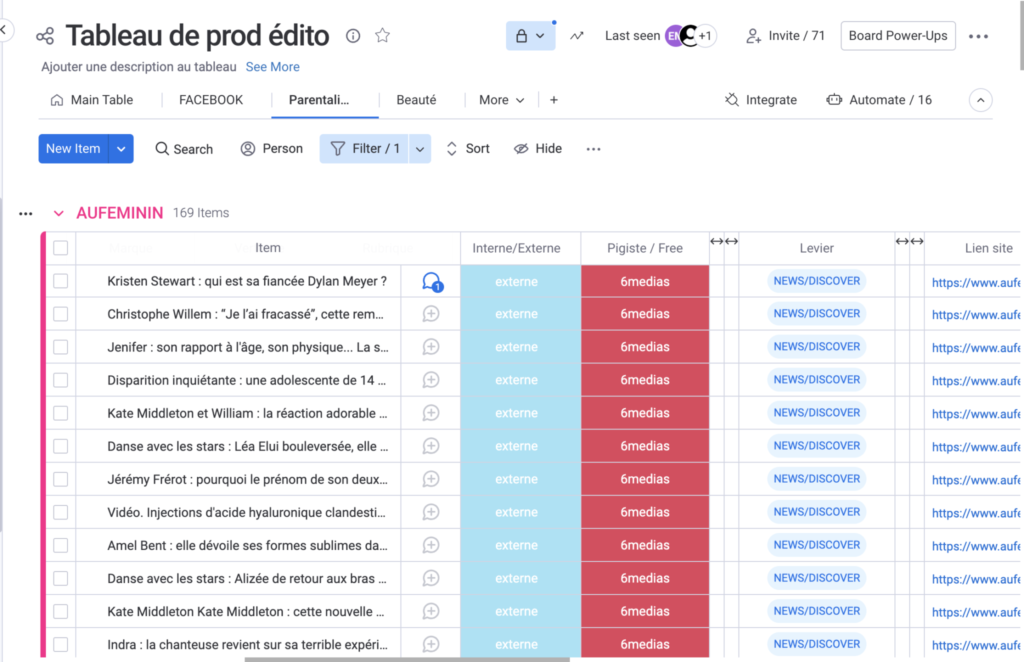Elodie Mandel is head of Unify group’s 3 women's brands: AuFeminin, Parole de Mamans and Beauté Test.
What actually is the purpose of my content? It’s a question I ask myself every time I write an article, create a video, slide show, or any content for that matter.
Managing an editorial office like aufeminin.com means an average of 50 pieces of content each day, produced by internal teams, freelancers, agencies and columnists. It also means 14 sections (Cooking, Fashion, Beauty, Families, Astro, Psycho, etc.), an editorial team to guide, traffic channels to diversify and amplify, and an editorial and traffic acquisition strategy to manage.
When I arrived at Aufeminin a year ago, I was confronted with a variety of challenges: from audience and turnover, to SEO strategy and editorial – a need for content that acquired audiences and content that helped form our image as a media. Rebuilding a brand whilst also giving positive signals to the market quickly (the famous ‘quick wins’). Redesigning the editorial, making editorial choices for each section, deciding on which formats to use… all complex issues that take time. But sometimes we don’t have time to wait for the results. So, how do you go about doing all of this quickly but effectively?
My first decision: change the format of our editorial meetings
We’ve formed a habit of coming together each morning to define which topics will be covered that day based on a re-designed spreadsheet. It’s at this point that we ask ourselves the question, what is the objective of my content? A simple question, but one that has led journalists to take a very different look at their work.

Produce, yes, but for whom?
Producing content is good, but not enough. It’s 2022, and players in the media industry have reached a certain level of maturity and power over audiences, meaning that if I want my article to be read, the first question to ask as a journalist is who I am addressing? Who’s my audience? Who’s reading my content? Who am I writing for?
Produce a little… or a lot? Another key question
The second question leads nicely on from the first: what is the right volume of content production? How can we make this decision? Based on audiences…? Yes, that’s the common metric, but not just this. Revenue generated (now and revenue to come in the future) is also essential.
If I decided to launch a tourism section, for instance, I’d invest according to a potential audience size and turnover from various sources (directly from the media, programmatic, affiliation, etc.).
Or, if I wanted to position our brand within the royal family news area and place highly on competitive keywords, I would have to build legitimacy by working on a sustained and well-thought out publication strategy for several weeks before I’d start seeing any results. The idea is to produce enough to produce efficiently as well as develop the profitability of editorial.
Why? What’s the objective of my content?
This is the third challenge: assigning a goal to each piece of content. We know that producing quality content has a cost, but a clear focus will help your article be a hit from the date of publication. You can then regularly update content to ensure it continues to perform well, because (importantly), the work isn’t finished when the article is published. It’s only just getting started…
Another essential thing in my job, and in an editor’s mission in my opinion, is to write to be read. Otherwise you might as well write your diary.
So, what objectives can you assign to each content to write to be read?
I can think of 3 main goals:
1) Strengthen our brand image
Here we’re talking about brand content, such as defining a new position in the market. At Aufeminin, whose editorial line evolved in 2022, we emphasize the sharing of authentic experiences, so “Testimony” content is an important vector. We’re not immune to a bit of sensationalism, but this won’t necessarily make for a top performing article. That said, this type of content positions us as a referent on a specific subject, potentially above competitors, and therefore helps to generate inbound links to the brand and attract advertisers.
The article’s goal: position us as a leader in the field.
It’s a success if: we win an award, if the professional press talks about us, if it generates social shares, if it generates a debate, comments on social media like Twitter, if it’s widely talked about, etc.
2) Engage our audiences
Aufeminin doesn’t yet have a paywall, but we’re currently considering it for the future and testing our readers’ appetite through “Aufem plus” section reserved for registered users only. The focus for this content is generally expert, always exclusive and involving a story-telling format that makes you want to read further than the wall. Serial content (which gradually unfolds the story) is interesting for this case.
Its added value compared to a non-exclusive piece or a competitor must be perceptible at a glance. From just the title and photo, readers should see that there’s a different angle here, more expertise and deeper analysis.
The article’s goal: Increase engagement to convert users through a funnel towards bringing a higher ARPU
It’s a success if: the time spent on-page is high. We also look at registration rates/conversion rates.
3) Reach a large audience
Obviously not the least of challenges. Aufeminin has been badly hit in the last few years by Google’s algorithm changes. So winning back audiences is a daily battle. Since my arrival: +104% of sessions in September 2022 vs. 2021, +90% PV on editorial (excluding the forum)… Our work is starting to bear fruit.
For the past 10 years, I’ve been working on mainstream traffic sources that best generate audiences, working through them one by one: SEO, Discover, social, referral, newsletters, push…
I’m not going to reveal any secrets here (even though we’re among friends), but in the current model of media sites, and particularly in the entertainment and women’s sites area, power is an asset for seducing advertisers and developing revenues via programmatic.
The recipe? A highly requested theme, a relevant angle, a well-chosen publication schedule, a contextual photo and content distribution on all of the brand’s platforms and beyond (such as with partners). And, of course, content that our readers are interested in.
It’s a success if: Discover features it! In terms of audience, Discover is much more powerful than Google News.
In these goals, I’m not talking about paywalled content (even though that’s definitely our next step) but even without blocking articles, it’s key to identify the content and services that users are prepared to pay for, and ones that would benefit from a reworked user experience.
Finally, I would add that each of these objectives requires a unique production organization and therefore a certain agility in production means. Maybe this would be better with an internal team? freelancers? agencies? columnists? AI?
What to publish when?
Those 50 articles produced daily at Au feminin don’t all deserve to be promoted on Facebook, to be pushed, to be put on the homepage… Cornelian choice or rather a clever mix, but it’s a balance to find.
A final thought to go away with:
What if statistics aren’t everything?
No Google Analytics, no AT Internet, no Crowd Tangle will be able to measure the familiarity and trust that audiences have in a media brand. How can you measure the attractiveness of a brand, its inspiring side? Likes, page views, time spent do not measure the love for a brand.
But finding the most accurate indicators of success for each content is another story.
